- Edge Hill Research Archive
advertisement
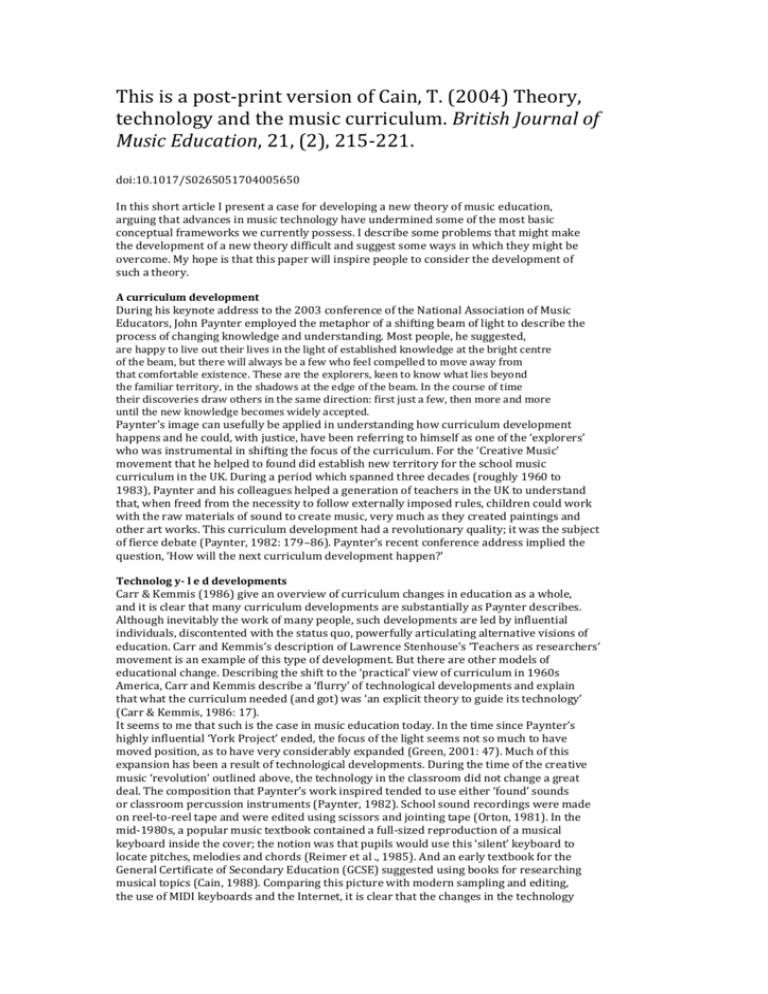
This is a post-print version of Cain, T. (2004) Theory, technology and the music curriculum. British Journal of Music Education, 21, (2), 215-221. doi:10.1017/S0265051704005650 In this short article I present a case for developing a new theory of music education, arguing that advances in music technology have undermined some of the most basic conceptual frameworks we currently possess. I describe some problems that might make the development of a new theory difficult and suggest some ways in which they might be overcome. My hope is that this paper will inspire people to consider the development of such a theory. A curriculum development During his keynote address to the 2003 conference of the National Association of Music Educators, John Paynter employed the metaphor of a shifting beam of light to describe the process of changing knowledge and understanding. Most people, he suggested, are happy to live out their lives in the light of established knowledge at the bright centre of the beam, but there will always be a few who feel compelled to move away from that comfortable existence. These are the explorers, keen to know what lies beyond the familiar territory, in the shadows at the edge of the beam. In the course of time their discoveries draw others in the same direction: first just a few, then more and more until the new knowledge becomes widely accepted. Paynter’s image can usefully be applied in understanding how curriculum development happens and he could, with justice, have been referring to himself as one of the ‘explorers’ who was instrumental in shifting the focus of the curriculum. For the ‘Creative Music’ movement that he helped to found did establish new territory for the school music curriculum in the UK. During a period which spanned three decades (roughly 1960 to 1983), Paynter and his colleagues helped a generation of teachers in the UK to understand that, when freed from the necessity to follow externally imposed rules, children could work with the raw materials of sound to create music, very much as they created paintings and other art works. This curriculum development had a revolutionary quality; it was the subject of fierce debate (Paynter, 1982: 179–86). Paynter’s recent conference address implied the question, ‘How will the next curriculum development happen?’ Technolog y- l e d developments Carr & Kemmis (1986) give an overview of curriculum changes in education as a whole, and it is clear that many curriculum developments are substantially as Paynter describes. Although inevitably the work of many people, such developments are led by influential individuals, discontented with the status quo, powerfully articulating alternative visions of education. Carr and Kemmis’s description of Lawrence Stenhouse’s ‘Teachers as researchers’ movement is an example of this type of development. But there are other models of educational change. Describing the shift to the ‘practical’ view of curriculum in 1960s America, Carr and Kemmis describe a ‘flurry’ of technological developments and explain that what the curriculum needed (and got) was ‘an explicit theory to guide its technology’ (Carr & Kemmis, 1986: 17). It seems to me that such is the case in music education today. In the time since Paynter’s highly influential ‘York Project’ ended, the focus of the light seems not so much to have moved position, as to have very considerably expanded (Green, 2001: 47). Much of this expansion has been a result of technological developments. During the time of the creative music ‘revolution’ outlined above, the technology in the classroom did not change a great deal. The composition that Paynter’s work inspired tended to use either ‘found’ sounds or classroom percussion instruments (Paynter, 1982). School sound recordings were made on reel-to-reel tape and were edited using scissors and jointing tape (Orton, 1981). In the mid-1980s, a popular music textbook contained a full-sized reproduction of a musical keyboard inside the cover; the notion was that pupils would use this ‘silent’ keyboard to locate pitches, melodies and chords (Reimer et al ., 1985). And an early textbook for the General Certificate of Secondary Education (GCSE) suggested using books for researching musical topics (Cain, 1988). Comparing this picture with modern sampling and editing, the use of MIDI keyboards and the Internet, it is clear that the changes in the technology available in the classroom have been considerable. Practical changes produced by new technologies Technological developments have brought with them practical changes in the music curriculum as teachers have incorporated new hardware and software into their teaching. Electronic keyboards and computers have given children a range of sounds that are often very similar to the ones heard in popular music, making it possible to relate more closely school music and the world outside. The ability to create music, layer by layer, to edit any aspect of it and to play it back at virtually any tempo has meant that children are now able to compose music that they cannot physically play (see Odam & Paterson, 2000: 19). New technologies have enabled pupils to understand better the relationship between music and visual images. For example, importing video files into a sequencing program such as Cubase gives pupils the possibility of composing music for the moving image in ‘real time’, making musical, artistic and technological decisions. And the ability to research musical topics on the Internet requires pupils to learn research skills, such as selecting relevant material and rejecting what is irrelevant (Crow, 2001: 159). New technologies have also meant changes to teaching styles and the role of the teacher. Before the ‘creative music’ developments, whole-class teaching seems to have been the norm, and Paynter’s work was influential in effecting a shift in emphasis to group work. Now, more and more, pupils are working either in pairs or as individuals, each with a workstation and a set of headphones. This demands a different approach to teaching, and also requires teachers to be technicians, performing ‘regular maintenance and careful management of resources’ (Odam & Paterson, 2000: 35). In addition, the new technologies have rendered public examinations in music problematic, creating difficulties, for example, in assessing the notation of compositions (Hodges, 2001). Sampling, sequencing and editing software have made it difficult, perhaps impossible, to judge the extent to which pupils’ work is their own, especially when it is done at home. This is true of composition, but also of performing, in cases when music technology is offered in place of ‘live’ performance (see also Byrne & MacDonald, 2002). Theoretical changes produced by new technologies These practical changes are very considerable, and, what is perhaps even more important, they have brought into question some of the most basic conceptual frameworks that have underpinned music teaching. (This need not necessarily be the case; the use of whiteboards, for instance, might cause a change in the way in which material is presented, without causing more fundamental changes in what we think of as appropriate material.) In his book A Basis for Music Education (1979), Keith Swanwick classified the core musical activities as composing, performing and audience-listening (which he initially called ‘audition’), with literature studies and skill development in supporting roles (Swanwick, 1979). This classification had considerable influence on music teaching and is still felt in the structure of the General Certificate of Secondary Education exam and the English National Curriculum, in which the programmes of study list the performing, composing and listening skills that are appropriate to particular stages of education (DfES, 1999). The importance of Swanwick’s model for the curriculum lay in the separation of those activities which engage people most directly with musical encounters (composing, audience-listening and performing) from other activities. Technological developments have now rendered this classification problematic. Programs such as Compose World (mostly used in primary schools) and the Ejay series (mostly in secondary schools) allow children to manipulate pre-composed sections of music, usually 1, 2 or 4 bars long. With programs such as Propellerhead’s Reason, pupils use a virtual studio to apply post-production techniques to whole songs which have been pre-composed. (They can also use this to enhance their own compositions.) Using basic DJ equipment and procedures such as back-spinning and scratching, children can ‘arrange’ recorded songs in real time; using sequencing software, they can remix songs in different styles. None of these classroom activities can be simply classified as composing, performing or audience-listening; neither are they primarily concerned with skill development or literature studies. Technological developments have thus called into question what we mean by the terms ‘composing’, ‘performing’ and ‘audience-listening’. Does the term ‘composing’ include manipulating sound samples composed by other people? Does ‘performing’ include entering performance parameters in ’step time’, before the sounds are heard, rather than as they happen? And how are we to understand recording and mixing tracks – is this simply an extension of ‘audience-listening’? What is the relationship between performer and listener, when the performance is mediated by a computer? How are we to understand Swanwick’s dictum ‘to care for music as discourse’ (Swanwick, 1999) when the nature of such discourse has, in some circumstances, changed so radically? Clearly there needs to be some redefining of terms, and an acceptance that the distinctions between terms are more blurred than has previously been thought; but this is only the beginning – the crucial question is, ‘To what extent do these activities provide meaningful, educational encounters with music?’ Music technology has also called into question Swanwick and Tillman’s (1986) account of the development of musical ability. Swanwick and Tillman’s research produced the famous ‘spiral’ which, they suggested, might provide a suitable framework for informing curriculum planning (Swanwick & Tillman, 1986: 335). They described how, at an early age, children explore the qualities of sound – sound materials. As they develop, they create music with a common vernacular, and, at some point in their teens, they tend to compose music within specific styles. This work has influenced the National Curriculum, in which ‘composing in different genres and styles’ is described as ‘Level 6’, the expected level for the majority of 14-year-olds (DfES, 1999: 37). How are we to understand work produced with the help of computer programs such as Rave Ejay and Hip-Hop Ejay which enable virtually anyone who can manipulate a mouse to create music within these styles? At this point I should make it clear that I am in favour of using the new technologies in teaching; I believe that they provide great benefits to the practice of music education, especially by improving access to music (Ellis, 1997; Hodges, 2001). I welcome the fact that new technologies help provide improved resources such as backing tracks, and allow pupils to take their work home, e.g. via school web sites. They also enable pupils to share their work with other people – young offenders (Savage & Challis, 2002) or people in other countries (Seddon et al ., 2003). Mills and Murray (2000) report that pupils are ‘almost without exception’ enthusiastic about music technology; it would be foolish not to use ICT in our teaching. But I believe that it requires us to rethink our conceptual frameworks, the tools we use for determining what is worthwhile. (I take for granted that it is primarily the teacher’s job to decide this.) In reformulating such frameworks, we won’t be starting from scratch. Hodges warns against the dangers of seeing ICT as an end in itself, rather than as ‘a means to achieve a musical outcome engaging aesthetic responsiveness’ (Hodges, 2001: 179). Mills and Murray found that music technology lessons were good when the pupils worked primarily as musicians (Mills & Murray, 2000: 140). Bray suggests that ICT helps when it enhances creativity, makes learning easier, encourages exploration and independence and involves appropriate learning objectives (Bray, 2000: 93). However, in my work I see some teachers who embrace ICT wholeheartedly, sometimes to the exclusion of singing and playing acoustic instruments (and with reason: if you’ve got 30 computers in your classroom, you want to get good use out of them), and others who virtually ignore it. This isn’t simply a question of money, although finances do play a part: it has more to do with the theories, subconscious and conscious, vague or well defined, that teachers have about the value of music technology. An adequate, overarching theory of music education that takes account of new technologies could help to locate music technology within the curriculum as a whole. Some obstacl e s Of course, teachers are perfectly capable of developing new theories, as Carr and Kemmis (1986) show. Unfortunately, however, the need to revise our conceptual frameworks comes at a time when the potential for teachers to effect change has decreased. Johnson and Hallgarten, researching into the views of UK teachers for the Institute for Public Policy Research (an independent charity), report that, at least in England, government initiatives are seen as diktats, and that ‘Ofsted [the inspection body] has operated as the Department’s police, checking on whether the initiatives have been implemented as instructed’ (Johnson & Hallgarten, 2002: 5). They say: The teachers involved in the research, while on the whole enthusiastic about their work, felt downtrodden, stressed, overworked and undervalued. Linked to all of the negative factors of the job . . .was a concern from both teachers and non-teachers that autonomy in the classroom is being undermined . . . The principle of a national curriculum was widely accepted at the time of its introduction, and has been hardly questioned since. Yet its detailed prescription . . . has de-skilled teachers in the sense that they have been discouraged from both questioning the curriculum needs of their pupils and also developing innovative programmes. (Johnson & Hallgarten, 2002: 3–4) The removal of autonomy leads to a lack of confidence, and there is evidence to suggest that music teachers no longer trust their own convictions. For example, in a small survey, Finney (2000) examined the place of singing in the curriculum. He found that most teachers valued singing as a classroom activity, describing it as ‘an aid to aural capability’, ‘the best way of training the ear’, and he said that ‘the pupil learning solely through an instrument has a very poor ear’. However, many teachers were not able to give singing the prominence it deserved: ‘[singing] has in practice a twilight existence and marginal role: teachers find it difficult to give it the significance that they frequently claim for it’ (Finney, 2000: 203). Finney acknowledges that many teachers’ knowledge about singing pedagogy is ‘limited’ and that, despite the benefits they see in singing, they lack the confidence to develop this pedagogy. In a conclusion which resonates with the findings of Johnson and Hallgarten, he says: The current model of prescription and inspection continues to be hostile to cooperation and joint problem solving amongst teachers. There is a tendency to look to fixed solutions. Risk, initiative and innovation are slow to flourish. (Finney, 2000: 209) Ways forward? Curriculum change is necessary if the world of the classroom is to keep pace with the world outside. And it is also necessary to have a clearly defined theory which allows teachers to commit themselves intellectually to the change. Inspired very largely by John Paynter, the ‘creative music’ movement revolutionised the music curriculum. In the process, however, it created opposing groups of teachers, some of whom embraced its approach to composition while others did not. A Basis for Music Education (Swanwick, 1979) helped to bridge the gap between the groups with a theory that located composition within the music curriculum as a whole. This is the sort of thing I believe we need with regard to music technology. To create such a theory, to work with it and to adapt it to our individual circumstances – to make it our own – will not be easy in the current climate, but it might be possible. Dialogue will be essential, especially between teachers who use technology a lot and those who use it reluctantly. ICT enthusiasts need to understand that those who are reluctant to use music technology might not be technophobes; they might have genuine and principled concerns, perhaps relating to certain less musical aspects of the technology. There needs to be a greater understanding of what children, including young children, learn from music technology. (Why is it not part of the English National Curriculum for 5–8-year-olds; what is the theory that supports this omission?) There needs to be more, and better, professional development, so that teachers can learn from each other, as well as from experts, how best to use music technology. And, given the current unhelpful climate described above, we need to be aware of Pitts’s exhortation that ‘the impetus for genuine change must come from the teacher rather than from the perceived threat of external agents’ (Pitts, 2000: 198). References BRAY, D. (2000) Teaching Music in the Secondary School. Oxford: Heinemann. BYRNE, C. & MACDONALD, R. (2002) ‘The use of information & communication technology in the Scottish music curriculum: a focus group investigation of themes and issues’. Music Education Research, 4, 2, 263–73. CAIN, T. (1988) Keynote: Music to GCSE. Cambridge: Cambridge University Press. CARR, W. & KEMMIS, S. (1986) Becoming Critical: Education, Knowledge and Action Research. London: Falmer Press. CROW, B. (2001) ‘Music-related ICT in education’, in C. Philpott (Ed.), Learning to Teach Music in the Secondary School, pp. 135–62. London: Routledge/Falmer. DfES (1999) The National Curriculum for England: Music. London: DfES & QCA. ELLIS, P. (1997) ‘The music of sound: a new approach for children with severe and profound and multiple learning difficulties’. British Journal of Music Education, 14, 2, 173–85. FINNEY, J. (2000) ‘Curriculum stagnation: the case of singing in the English National Curriculum’. Music Education Research, 2, 2, 203–11. GREEN, L. (2001) ‘Music in society and education’, in C. Philpott & C. Plummeridge (Eds.), Issues in Music Teaching. London: Routledge/Falmer. JOHNSON, M. & HALLGARTEN, J. (2002) From Victims of Change to Agents of Change: The Future of the Teaching Profession. London: ippr. HODGES, R. (2001) ‘Using ICT in music teaching’, in C. Philpott & C. Plummeridge (Eds.), Issues in Music Teaching. London: Routledge/Falmer. MILLS, J. & MURRAY, A. (2000) ‘Music technology inspected: good teaching in Key Stage 3’. British Journal of Music Education, 17, 2, 129–56. ODAM, G. & PATERSON, A. (2000) Composing in the Classroom: The Creative Dream. High Wycombe: National Association of Music Educators. ORTON, R. (1981) Electronic Music for Schools. Cambridge: Cambridge University Press. PAYNTER, J. (1982) Music in the Secondary School Curriculum. Cambridge: Cambridge University Press. PITTS, S. (2000) A Century of Change in Music Education. Aldershot: Ashgate. REIMER, B., HOFFMAN, M. E. & MCNEIL, A. (1985) Silver Burdett Music. Morristown: Silver Burdett Company. SAVAGE, J. & CHALLIS, M. (2002) ‘A digital arts curriculum? Practical ways forward’. Music Education Research, 4, 1, 7–23. SEDDON, F. A., JOUBERT, M. M., JOHNSEN, G. & TANGENES, Y. (2003) ‘Cross-cultural collaborative computer-mediated composition in cyberspace’. Proceedings of the Research Conference on Music Teaching and Learning, International Centre for Research in Music Education (ICRME), University of Reading, 18–19 July (2003). SWANWICK, K. (1979) A Basis for Music Education. London: Routledge. SWANWICK, K. (1999) Teaching Music Musically. London: Routledge/Falmer. SWANWICK, K. & TILLMAN, J. (1986) ‘The sequence of musical development: a study of children’s composition’. British Journal of Music Education, 3, 3, 305–39.
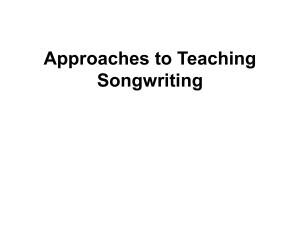
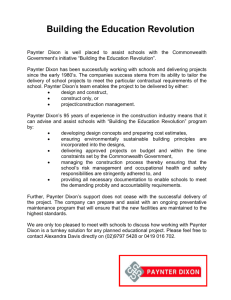
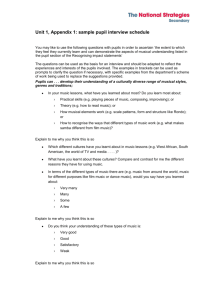
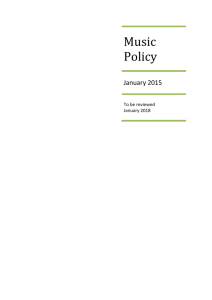



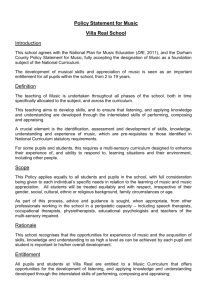
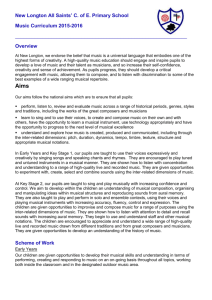
![afl_mat[1]](http://s2.studylib.net/store/data/005387843_1-8371eaaba182de7da429cb4369cd28fc-300x300.png)